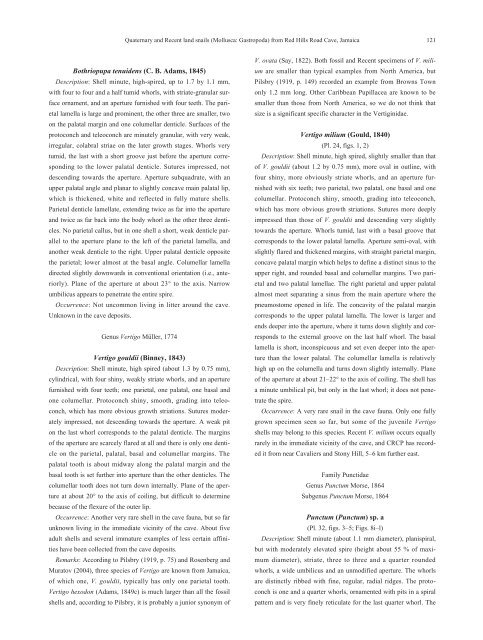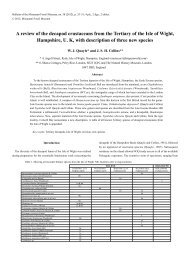Quaternary and Recent land snails (Mollusca: Gastropoda) from ...
Quaternary and Recent land snails (Mollusca: Gastropoda) from ...
Quaternary and Recent land snails (Mollusca: Gastropoda) from ...
Create successful ePaper yourself
Turn your PDF publications into a flip-book with our unique Google optimized e-Paper software.
<strong>Quaternary</strong> <strong>and</strong> <strong>Recent</strong> l<strong>and</strong> <strong>snails</strong> (<strong>Mollusca</strong>: <strong>Gastropoda</strong>) <strong>from</strong> Red Hills Road Cave, Jamaica 121<br />
Bothriopupa tenuidens (C. B. Adams, 1845)<br />
Description: Shell minute, high-spired, up to 1.7 by 1.1 mm,<br />
with four to four <strong>and</strong> a half tumid whorls, with striate-granular surface<br />
ornament, <strong>and</strong> an aperture furnished with four teeth. The parietal<br />
lamella is large <strong>and</strong> prominent, the other three are smaller, two<br />
on the palatal margin <strong>and</strong> one columellar denticle. Surfaces of the<br />
protoconch <strong>and</strong> teleoconch are minutely granular, with very weak,<br />
irregular, colabral striae on the later growth stages. Whorls very<br />
tumid, the last with a short groove just before the aperture corresponding<br />
to the lower palatal denticle. Sutures impressed, not<br />
descending towards the aperture. Aperture subquadrate, with an<br />
upper palatal angle <strong>and</strong> planar to slightly concave main palatal lip,<br />
which is thickened, white <strong>and</strong> reflected in fully mature shells.<br />
Parietal denticle lamellate, extending twice as far into the aperture<br />
<strong>and</strong> twice as far back into the body whorl as the other three denticles.<br />
No parietal callus, but in one shell a short, weak denticle parallel<br />
to the aperture plane to the left of the parietal lamella, <strong>and</strong><br />
another weak denticle to the right. Upper palatal denticle opposite<br />
the parietal; lower almost at the basal angle. Columellar lamella<br />
directed slightly downwards in conventional orientation (i.e., anteriorly).<br />
Plane of the aperture at about 23° to the axis. Narrow<br />
umbilicus appears to penetrate the entire spire.<br />
Occurrence: Not uncommon living in litter around the cave.<br />
Unknown in the cave deposits.<br />
Genus Vertigo Müller, 1774<br />
Vertigo gouldii (Binney, 1843)<br />
Description: Shell minute, high spired (about 1.3 by 0.75 mm),<br />
cylindrical, with four shiny, weakly striate whorls, <strong>and</strong> an aperture<br />
furnished with four teeth; one parietal, one palatal, one basal <strong>and</strong><br />
one columellar. Protoconch shiny, smooth, grading into teleoconch,<br />
which has more obvious growth striations. Sutures moderately<br />
impressed, not descending towards the aperture. A weak pit<br />
on the last whorl corresponds to the palatal denticle. The margins<br />
of the aperture are scarcely flared at all <strong>and</strong> there is only one denticle<br />
on the parietal, palatal, basal <strong>and</strong> columellar margins. The<br />
palatal tooth is about midway along the palatal margin <strong>and</strong> the<br />
basal tooth is set further into aperture than the other denticles. The<br />
columellar tooth does not turn down internally. Plane of the aperture<br />
at about 20° to the axis of coiling, but difficult to determine<br />
because of the flexure of the outer lip.<br />
Occurrence: Another very rare shell in the cave fauna, but so far<br />
unknown living in the immediate vicinity of the cave. About five<br />
adult shells <strong>and</strong> several immature examples of less certain affinities<br />
have been collected <strong>from</strong> the cave deposits.<br />
Remarks: According to Pilsbry (1919, p. 75) <strong>and</strong> Rosenberg <strong>and</strong><br />
Muratov (2004), three species of Vertigo are known <strong>from</strong> Jamaica,<br />
of which one, V. gouldii, typically has only one parietal tooth.<br />
Vertigo hexodon (Adams, 1849c) is much larger than all the fossil<br />
shells <strong>and</strong>, according to Pilsbry, it is probably a junior synonym of<br />
V. ovata (Say, 1822). Both fossil <strong>and</strong> <strong>Recent</strong> specimens of V. milium<br />
are smaller than typical examples <strong>from</strong> North America, but<br />
Pilsbry (1919, p. 149) recorded an example <strong>from</strong> Browns Town<br />
only 1.2 mm long. Other Caribbean Pupillacea are known to be<br />
smaller than those <strong>from</strong> North America, so we do not think that<br />
size is a significant specific character in the Vertiginidae.<br />
Vertigo milium (Gould, 1840)<br />
(Pl. 24, figs. 1, 2)<br />
Description: Shell minute, high spired, slightly smaller than that<br />
of V. gouldii (about 1.2 by 0.75 mm), more oval in outline, with<br />
four shiny, more obviously striate whorls, <strong>and</strong> an aperture furnished<br />
with six teeth; two parietal, two palatal, one basal <strong>and</strong> one<br />
columellar. Protoconch shiny, smooth, grading into teleoconch,<br />
which has more obvious growth striations. Sutures more deeply<br />
impressed than those of V. gouldii <strong>and</strong> descending very slightly<br />
towards the aperture. Whorls tumid, last with a basal groove that<br />
corresponds to the lower palatal lamella. Aperture semi-oval, with<br />
slightly flared <strong>and</strong> thickened margins, with straight parietal margin,<br />
concave palatal margin which helps to define a distinct sinus to the<br />
upper right, <strong>and</strong> rounded basal <strong>and</strong> columellar margins. Two parietal<br />
<strong>and</strong> two palatal lamellae. The right parietal <strong>and</strong> upper palatal<br />
almost meet separating a sinus <strong>from</strong> the main aperture where the<br />
pneumostome opened in life. The concavity of the palatal margin<br />
corresponds to the upper palatal lamella. The lower is larger <strong>and</strong><br />
ends deeper into the aperture, where it turns down slightly <strong>and</strong> corresponds<br />
to the external groove on the last half whorl. The basal<br />
lamella is short, inconspicuous <strong>and</strong> set even deeper into the aperture<br />
than the lower palatal. The columellar lamella is relatively<br />
high up on the columella <strong>and</strong> turns down slightly internally. Plane<br />
of the aperture at about 21–22° to the axis of coiling. The shell has<br />
a minute umbilical pit, but only in the last whorl; it does not penetrate<br />
the spire.<br />
Occurrence: A very rare snail in the cave fauna. Only one fully<br />
grown specimen seen so far, but some of the juvenile Vertigo<br />
shells may belong to this species. <strong>Recent</strong> V. milium occurs equally<br />
rarely in the immediate vicinity of the cave, <strong>and</strong> CRCP has recorded<br />
it <strong>from</strong> near Cavaliers <strong>and</strong> Stony Hill, 5–6 km further east.<br />
Family Punctidae<br />
Genus Punctum Morse, 1864<br />
Subgenus Punctum Morse, 1864<br />
Punctum (Punctum) sp. a<br />
(Pl. 32, figs. 3–5; Figs. 8i–l)<br />
Description: Shell minute (about 1.1 mm diameter), planispiral,<br />
but with moderately elevated spire (height about 55 % of maximum<br />
diameter), striate, three to three <strong>and</strong> a quarter rounded<br />
whorls, a wide umbilicus <strong>and</strong> an unmodified aperture. The whorls<br />
are distinctly ribbed with fine, regular, radial ridges. The protoconch<br />
is one <strong>and</strong> a quarter whorls, ornamented with pits in a spiral<br />
pattern <strong>and</strong> is very finely reticulate for the last quarter whorl. The





